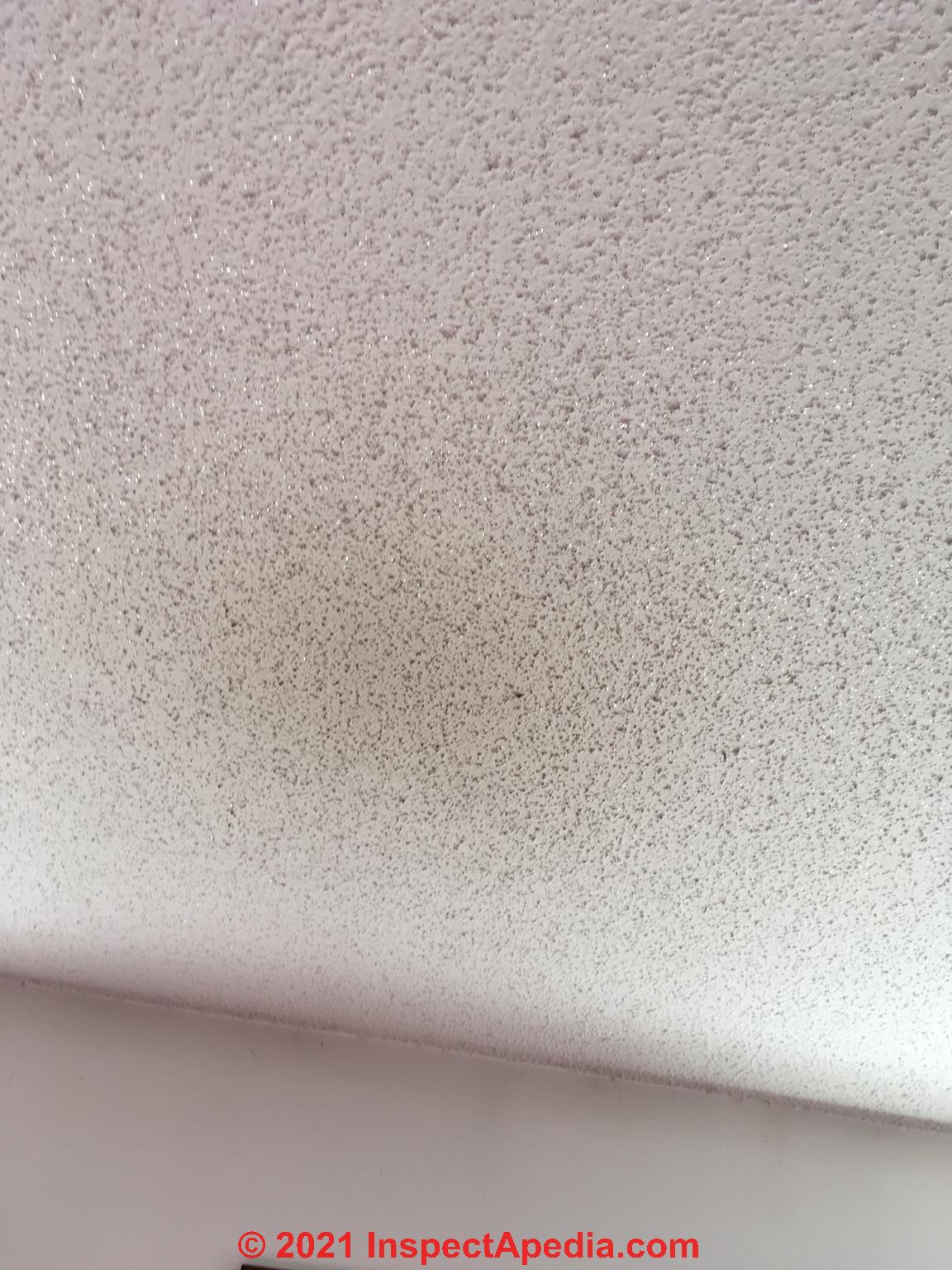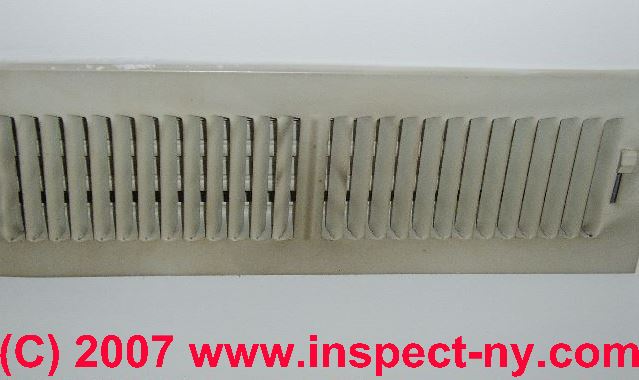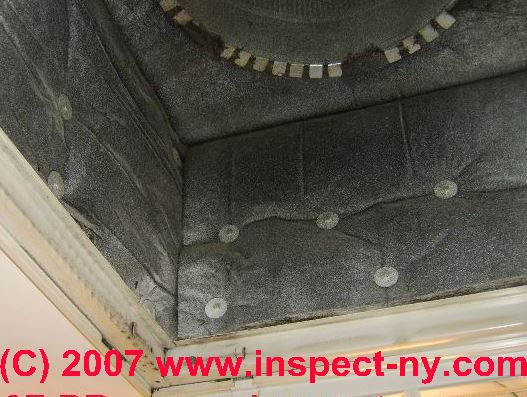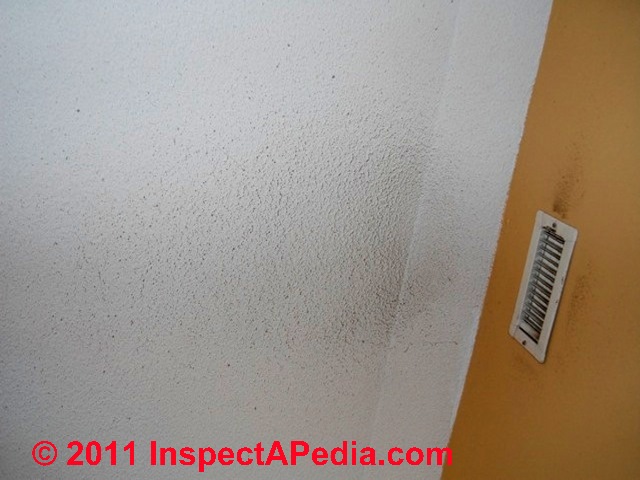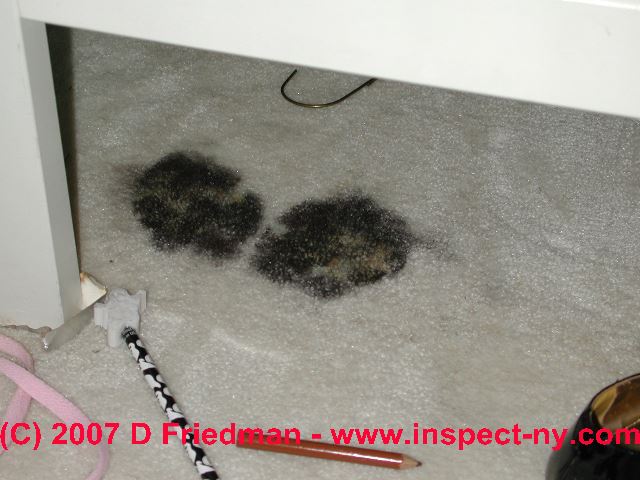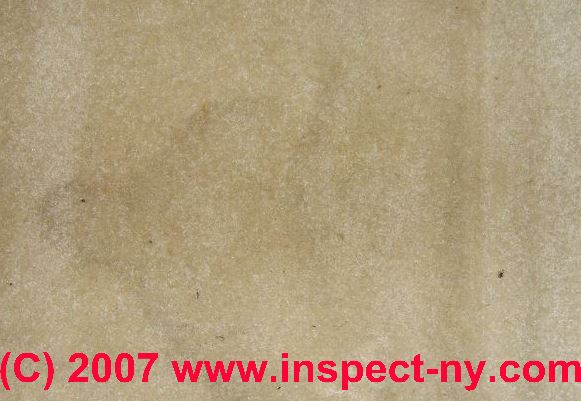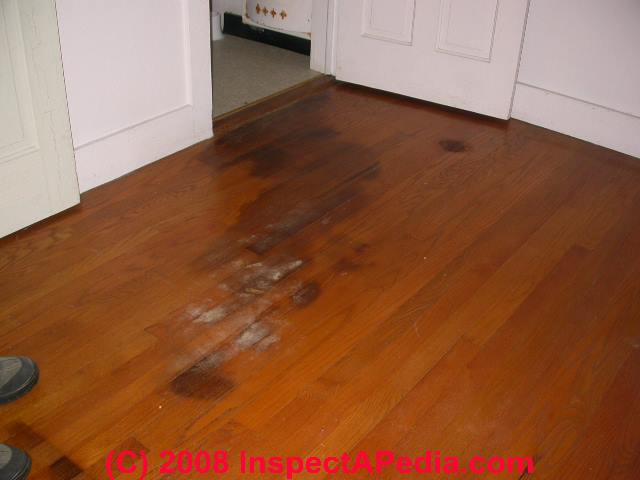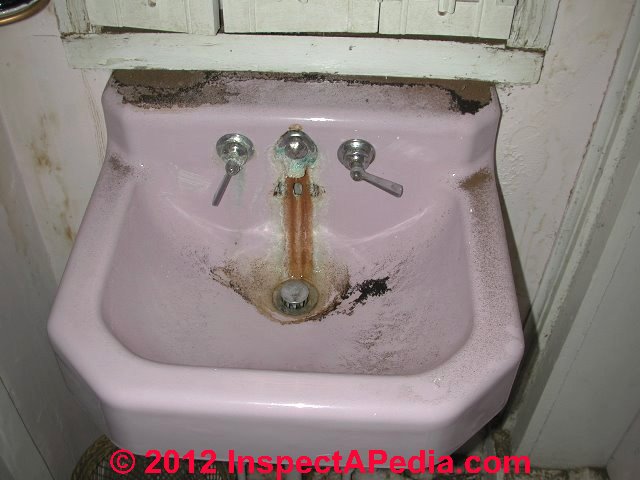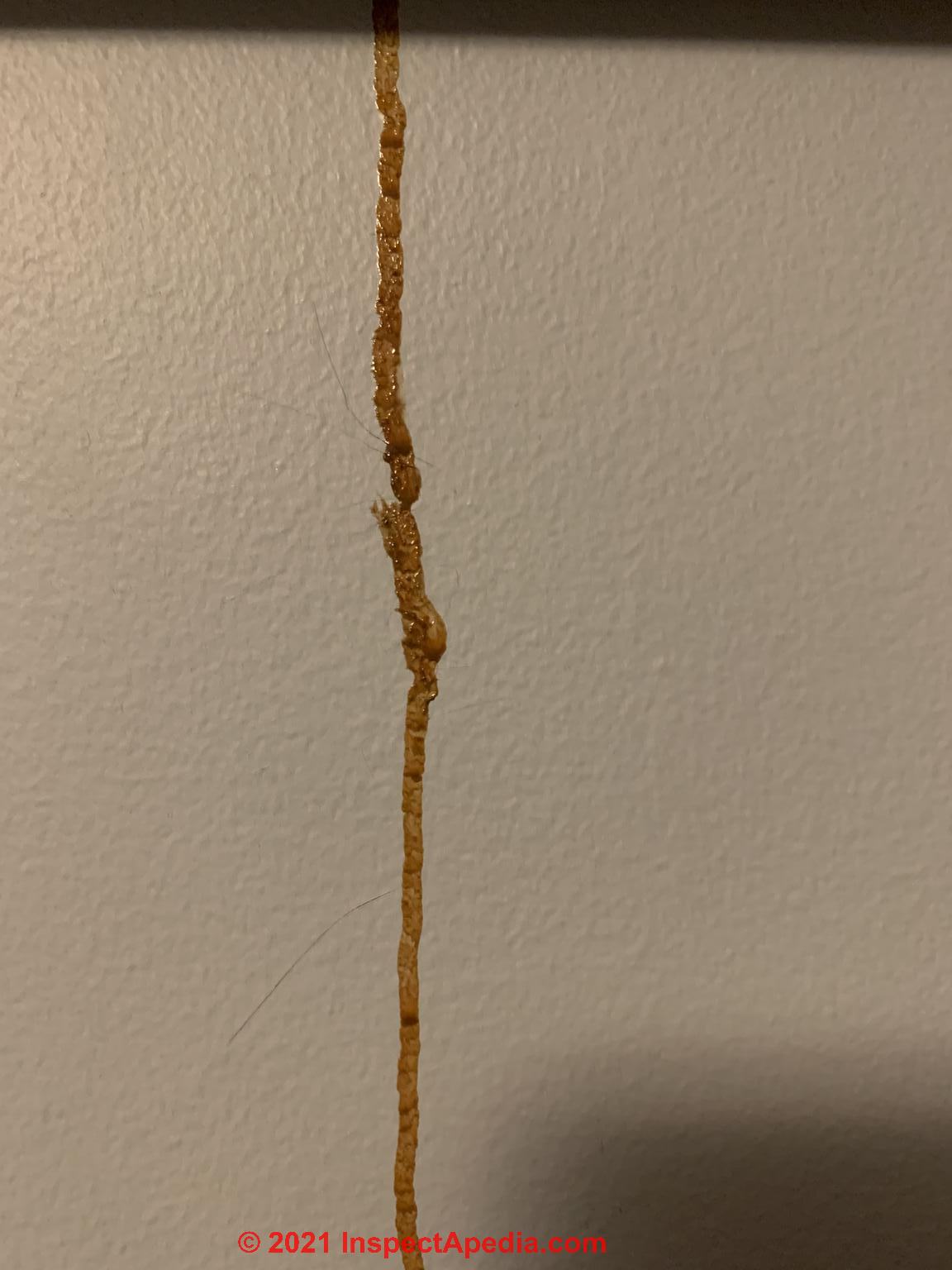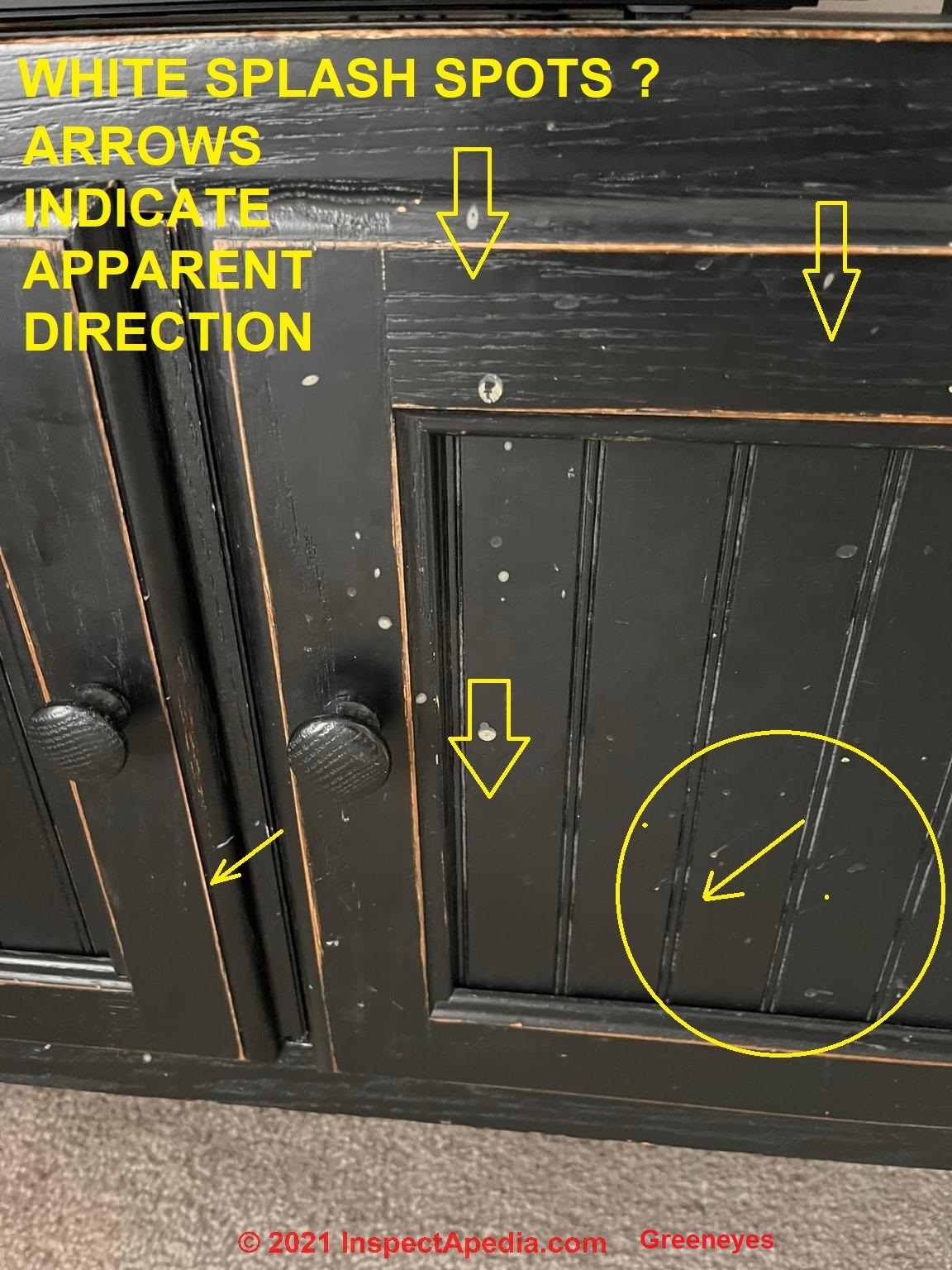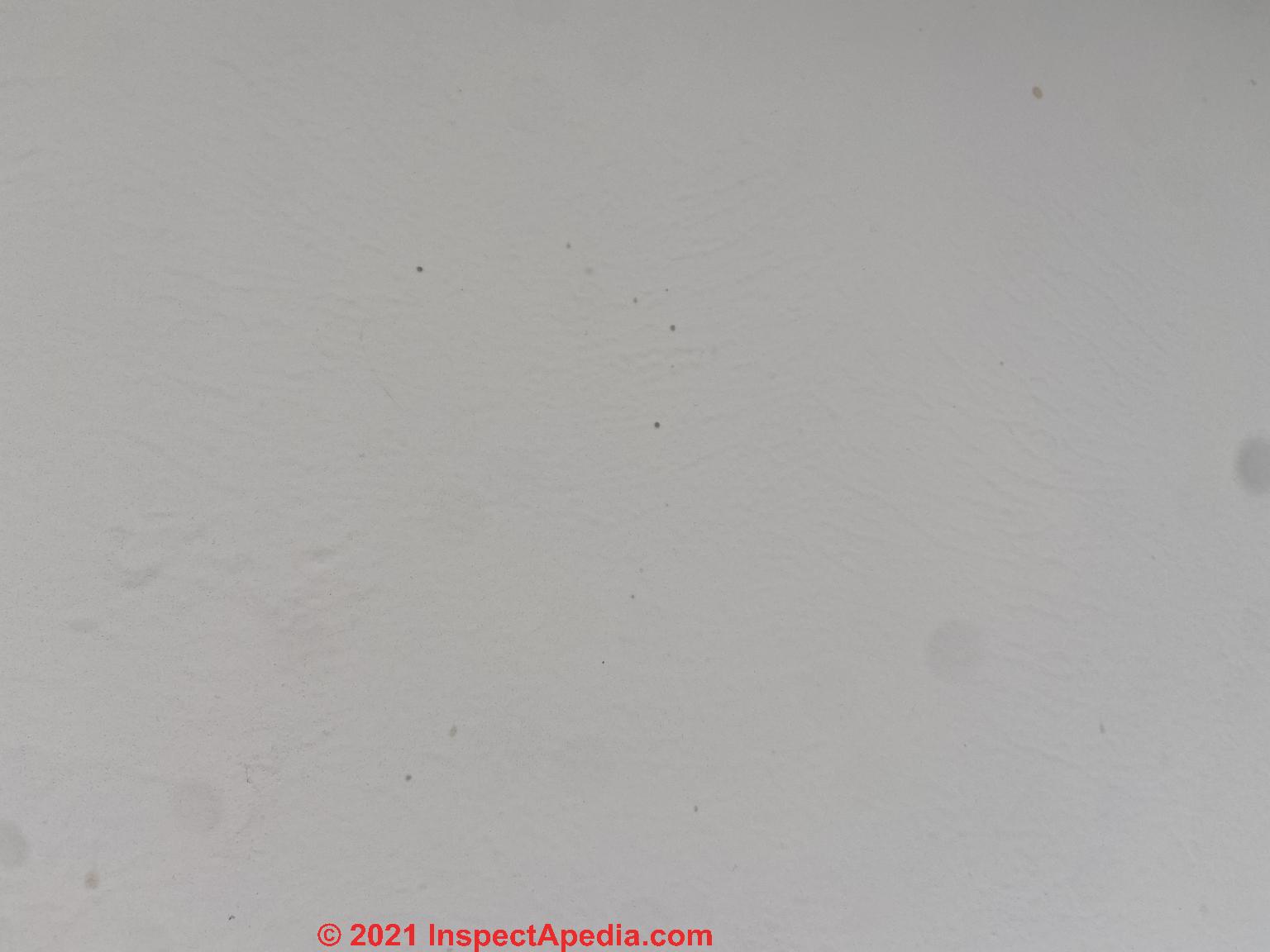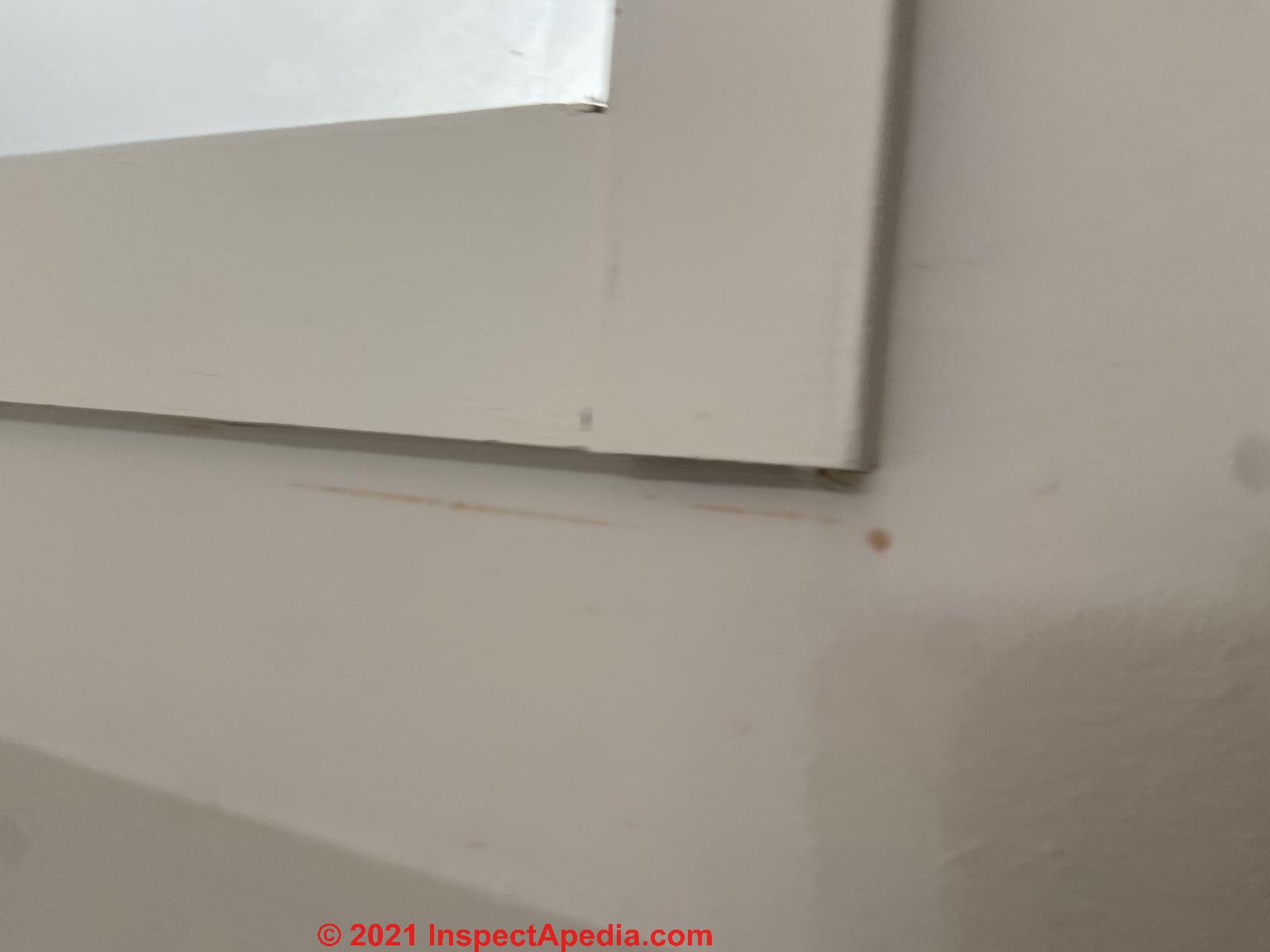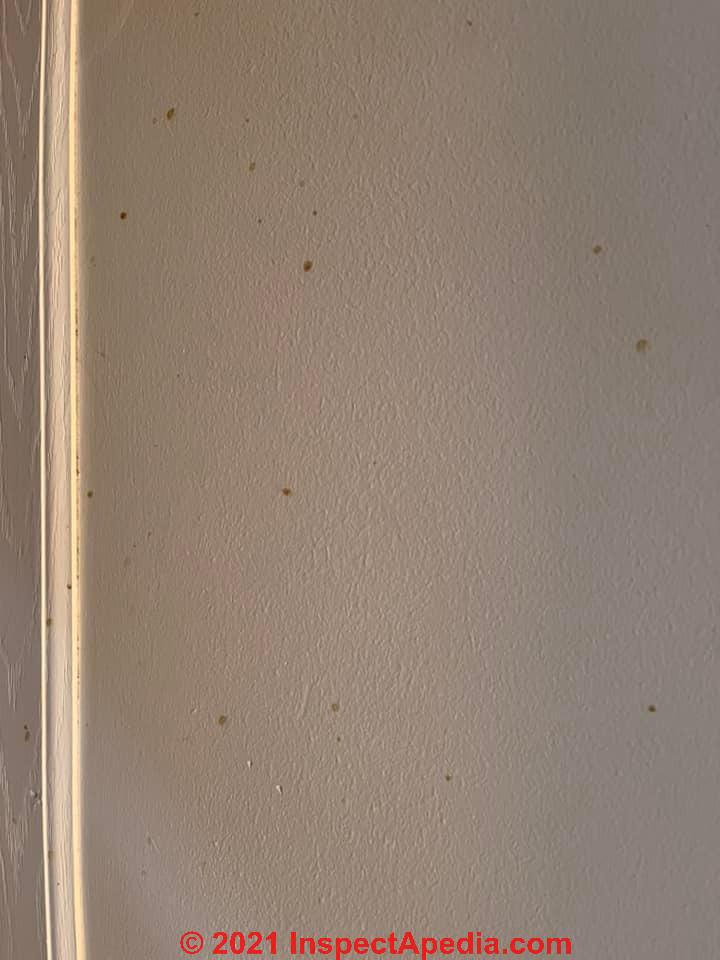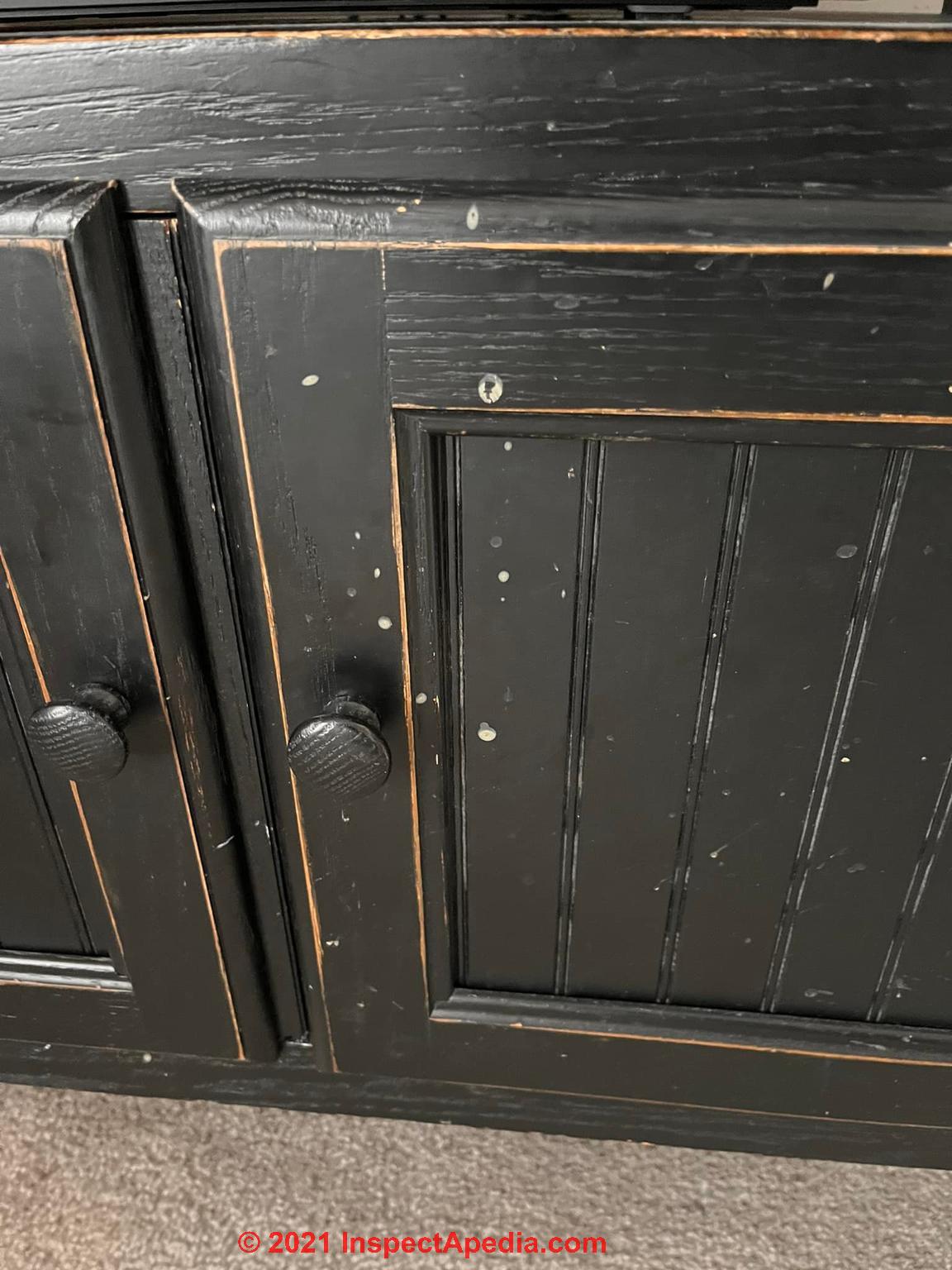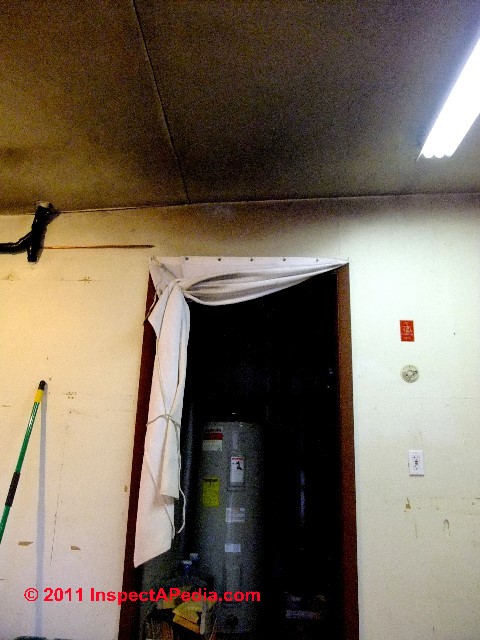 Guide to Stains on Indoor Surfaces in buildings
Guide to Stains on Indoor Surfaces in buildings
Photos of indoor stains help identify the stain source
Knowing the stain source tells us what repair is needed
House dust vs. thermal tracking vs. dangerous soot sources
- POST a QUESTION or COMMENT about identifying the cause and finding the cure for indoor stains on ceilings, walls, floors, carpeting, furniture, and other indoor surfaces and materials
Pictures help diagnose types & causes of stains on indoor surfaces & materials:
This article describes, provides photographs, & diagnoses the causes of interior wall, ceiling, flooring or carpeting stains and explains how to recognize their probable cause and source, including soot stains, house dust stains, pet or animal stains, and thermal tracking or thermal bridging stains associated with building air leaks, and building insulation defects.
Page top photo: dark soot stains on a garage ceiling outside the door to the boiler room housing an oil fired boiler suggest a history of very poor oil burner operation and a risk of a puffback explosion.
InspectAPedia tolerates no conflicts of interest. We have no relationship with advertisers, products, or services discussed at this website.
- Daniel Friedman, Publisher/Editor/Author - See WHO ARE WE?
Photographs Help Diagnose Causes of Indoor Stains
![]() Often dark indoor ceiling, wall, carpet or floor stains are mistaken for toxic indoor mold when they come from other causes instead.
Often dark indoor ceiling, wall, carpet or floor stains are mistaken for toxic indoor mold when they come from other causes instead.
Our photo shows dark rectangular stains identified as thermaltracking deposits of house dust where some ceiling areas are more cool than others.
Here are some examples of troubling indoor surface stains with some preliminary opinions about what these stains may be about.
Article Contents
- DARK or BLACK "GHOSTING" STAINS on SURFACES
- IS IT A STAIN or SOMETHING ELSE? - "Phantom" stains may be natural color variations; how to tell the difference.
- HVAC AIR REGISTER DIRT, DEBRIS STAINS
- HVAC AIR FILTER STAIN IDENTIFICATION - may help diagnose other HVAC or indoor air concerns
- CARPET MOLD STAINS
- CARPET STAINS OTHER THAN MOLD
- CARPET LIGHT AREAS - faded, bleached, cleaning spots
- CEILING & WALL STAINS
- FLOOR STAINS - on wood, vinyl, other materials
- PLUMBING FIXTURE STAINS - on sinks, tubs, showers, tile
- LINES or DRIPS / RUN-DOWN STAINS - on building surfaces
- SPOT STAINS - causes of small spots or areas of discoloration on building surfaces
We emphasize preliminary opinion because here we comment on these photos before an expert diagnostic building inspection has been performed and before any lab samples have been collected and analyzed from these surfaces.
Whether or not such sampling and analysis are justified depends on the experience of the building occupants (health complaints or health vulnerability), the history of the building (exposure to leaks, damage, pets, contaminants), and other site investigative results.
When investigating a building for a mold problem, you can save mold test costs by learning
how to recognize
MOLD APPEARANCE - STUFF THAT IS NOT MOLD or is only Harmless Mold but may be mistaken for more serious contamination - save your money.
Because some clients have on occasion sent samples to our mold test lab that really should not have been collected, much less looked at, we provide this library of photographs of things that are "not mold" and don't need to be tested.
"Black mold" often mistaken for "toxic fungal growth." Photos of HVAC and carpet stains (excluding the moldy carpet photos) were provided courtesy of Pat Belkin, Charlotte, NC.
See MOLD / ENVIRONMENTAL EXPERT, HIRE ? for help in deciding when to go further.
...
Dark Stains on Walls & Ceilings: ghosting, soot, pets, other
These reader Q&A offer examples of types of very common dark stains found indoors that may be due to thermal tracking or ghosting or to electrical equipment, pets, or other causes.
Watch out: some indoor stains such as sooting from gas fired heating equipment are signs of danger, risking fatal carbon monoxide poisoning or unsafe heating equipment. If your heating equipment is blowing out soot, turn it off and call for emergency repair.
Diagnose these Dark Stains found on Indoor Surfaces
Here are four images of several different “ghosting issues”. Please tell us which of these are dangerous.
1. Stains at a light fixture
2. Stains at a smoke detector
3. Stains at an air duct supply registers
4. Stains near where we burned candles
1. Are these black "burn marks" near our ceiling light fixture caused by the LED bulbs?
Light fixture burn marks. Is it LED light bulbs? We have several light fixtures with this issue. Lights are burning out very quickly even when the “wattage rating” is much lower than rating allows.
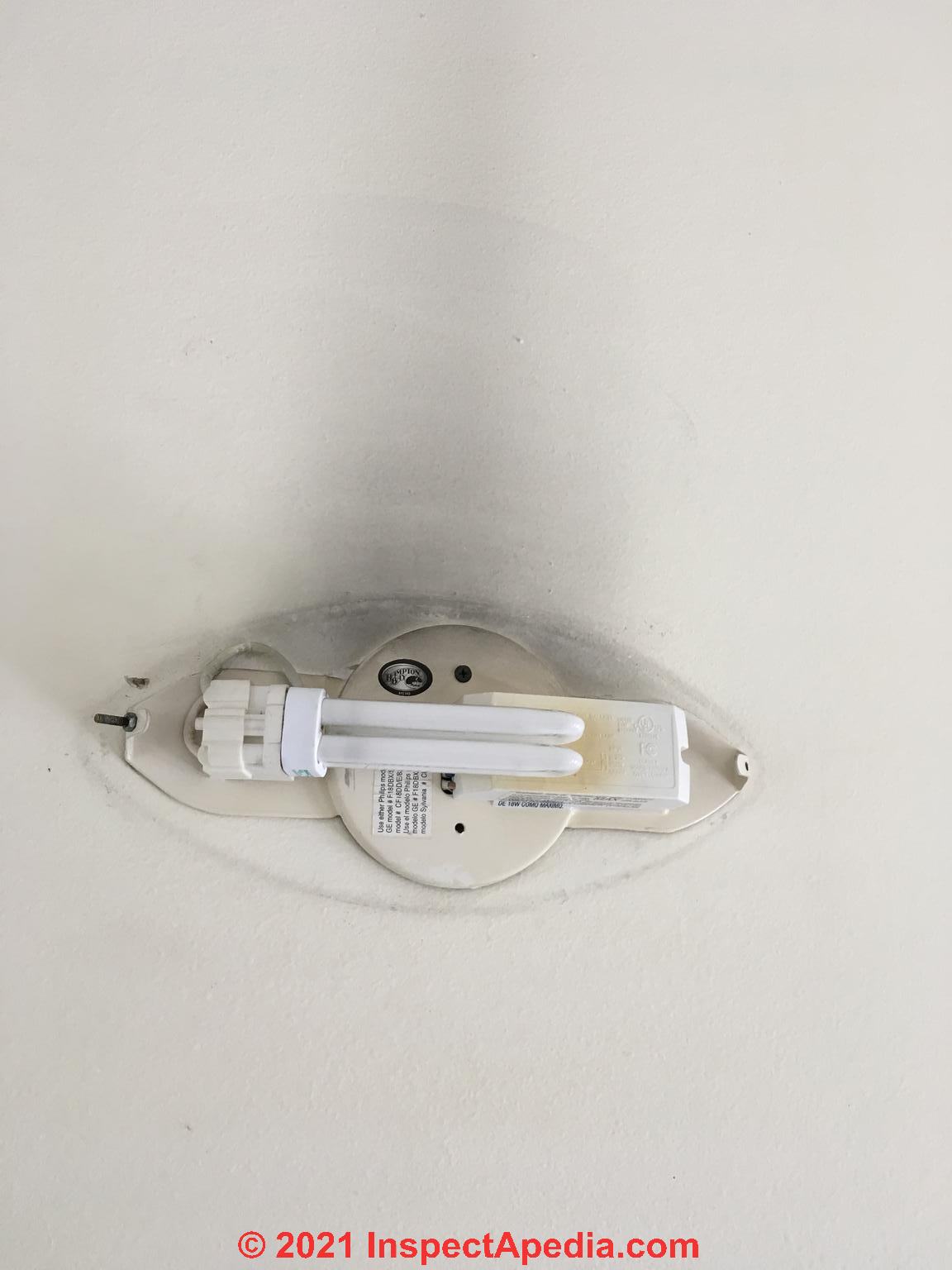
Reply:
@Mary Schwartz,
Watch out: if a light fixture component or wiring is burned or damaged from overheating - as may be caused by using a bulb at higher wattage than the fixture permits - then the fixture is unsafe and is a fire hazard - Ed.
I agree that there are numerous small soot stain marks on your ceilings and walls, each where there appears to be a source of thermal or air movement.
I can't say for sure that the soot source is scented candles - the cost of an actual forensic lab analysis of the soot is probably prohibitive and would not be as well-spent as a thorough inspection of your building to address safety concerns first, such as proper operation of a gas or oil fired furnace.
See THERMAL TRACKING STAINS for detailed discussion of this phenomenon and how to diagnose it.
2. Smoke detector “ghosting” - Is it airflow issues?
On 2021-02-20 by Mary Schwartz
Moderator reply: black stains above a smoke detectorThose dark stains on wall above a smoke detector are probably ghosting due to air currents caused by heat from the smoke detector's own electronics.
Occasionally we see a small vertical stain above a hole in a wall (such as may have been cut to wire or mount the smoke detector) that are traced to air leaks. I'd seal the hole in the wall with fire-rated foam but first,
for safey it's time to install a new smoke detector. - Ed.
Then also see
3. What about these ceiling stains at the air register?
HVAC airflow ghosting?
[Below: house dust or soot stains at an HVAC ceiling air supply register - Watch out: check the safety of the heating equipment - Ed. ]
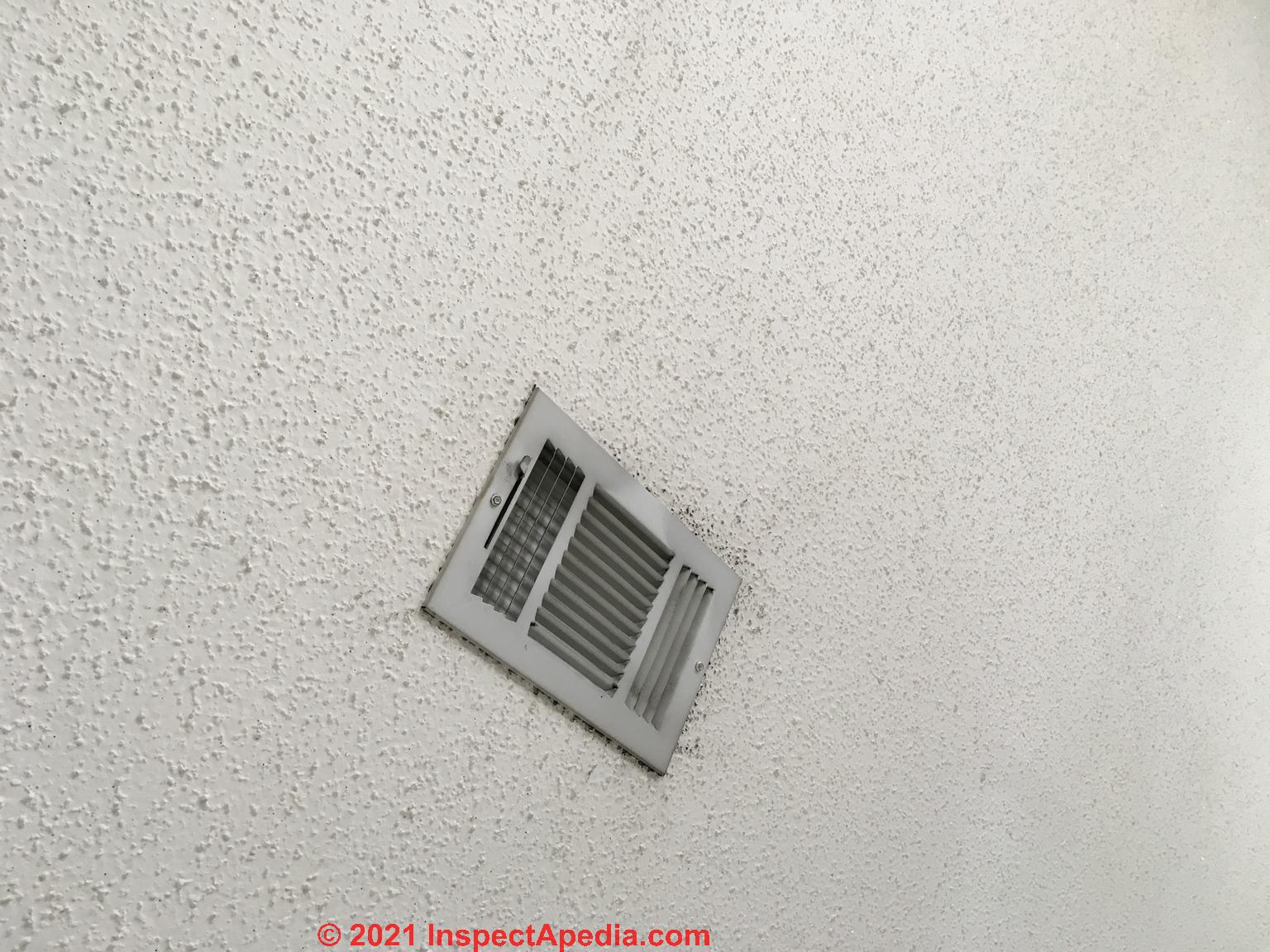
Moderator reply:
That may be normal house dust deposted at and near an air supply register.
Also see STAINS HVAC SOOT or DUST
Watch out: check for sooty or dirty HVAC air handler and include a safety check that the oil or gas burner is working properly.
4. Are these dark ceiling stains caused by scented candle "ashing" ?
On 2021-02-20 by Mary Schwartz
Moderator reply:
Quite likely yes, that's a stain from a candle or scented candle if you've been using them indoors.
Take a look at our examples at
...
Phantom Stains on Indoor Surfaces
 Is it a stain or someting else?
Is it a stain or someting else?
Often when people become concerned about indoor air quality, mold, or stains, they begin to study their building surfaces more carefully than ever before.
When this happens we sometimes find people reporting as "new" stains that were there from original construction, but where simply not noticed, or were not so particularly noticed before other concerns increased their level of attention.
This interesting photograph of a large yellowish stain on the surface of what appears to be a birch kitchen cabinet door surface (probably the door's interior surface) could be an example of this phenomenon.
What would support the "phantom stain" hypothesis for an item such as this cabinet door?
Stain pattern: If the stain appears in a regular pattern on companion surfaces such as other cabinet doors it may be an artifact of the door's manufacture
Stain location: If examination of other cabinet surfaces shows similar stains in varying locations
Manufacturing artifacts: If examination of sample cabinets from the same supplier or manufacturer, new, say in a showroom, show similar markings
Ability to remove surface staining material: If a tape sample cannot remove any debris from this are of darkened color
Stain particulate or chemical components: If a tape sample of surface debris removed particles which are determined to be finish coatings or wood fibers without fungal or chemical modification,
Presence of common causes of stains: If there are no moisture, food, air movement, or other suspect sources that have affected some of these cabinets but not others
Time of occurrence of stain: If the stain is under the finish-coating of the wood cabinet surface rather than something which was deposited on top of the coating (though indeed moisture can in some circumstances affect surfaces below their coating)
then this may be the case with this example photo of a yellowish stain on a birch ply cabinet door interior
...
Stains at Heating or Cooling Supply or Return Registers or Plenums
Supply Register debris: The photo above shows typical house dust deposition on a heating or cooling ceiling air supply register, where you can see brown debris adhered to the metal register surface. A second example is in our photo below.
These particles adhere to the register surface due to either moisture from condensation or in this location, more likely due to static electricity as particles are moving across a normally dry surface.
See STAINS at HVAC Supply Registers for more examples.
What to do about supply register debris:
House dust, normally composed primarily of human skin cells and fabric fibers, is not usually an environmental or air quality issue, though at high levels on surfaces it can be diagnostic of building conditions such as high moisture or poor HVAC system maintenance.
We can reduce this debris deposition by duct and air handler cleaning and by better and constant maintenance of filters at the return air registers. If other information disclosed by the building investigation warrants, one have this debris screened for mold, allergens or other problematic particles by using a forensic laboratory whose technicians are expert in house dust analysis.
Return register & return air plenum debris:
The right hand photo shows a combination of paint overspray (white particles on the black return plenum insulation liner), and house dust (brown debris on the metal frame intended to hold a return air filter).
What to do about return plenum debris:
The brown dust and debris indicates that the air filter used at this location has been leaky.
See AN ANALYSIS OF THE EFFECTIVENESS OF AIR FILTERS ON HVAC SYSTEMS for further advice on air filters that do not leak in this location.
...
Identify Stains & Discoloration on Heating or Air Conditioning Filters
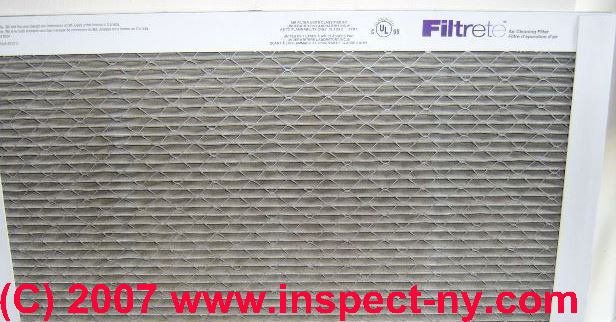
Air filter debris: This home air filter was taken from the central return air plenum and register cover shown in the photograph just above.
The brownish stains on the filter are a typical color (brown to gray) of debris found on any indoor air filter. Such
"stains' indicate that the filter is doing its job of reducing the level of airborne debris in the building.
What to do about air filter debris heating and air conditioning filters should be changed at least monthly whenever this equipment is in operation. In a dusty environment more frequent changes may be needed.
Also see An Analysis of the EFFECTIVENESS of AIR FILTERS on HVAC Systems for further advice on air filters that do not leak in this location and
also see WHEN TO HIRE a PROFESSIONAL to investigate a building for help in deciding when to go further in inspecting, diagnosing, and testing particles and debris on a building air filter. In many circumstances further testing would not be justified.
...
How to Diagnose Mold Stains & Mold Growth on Floor Carpeting
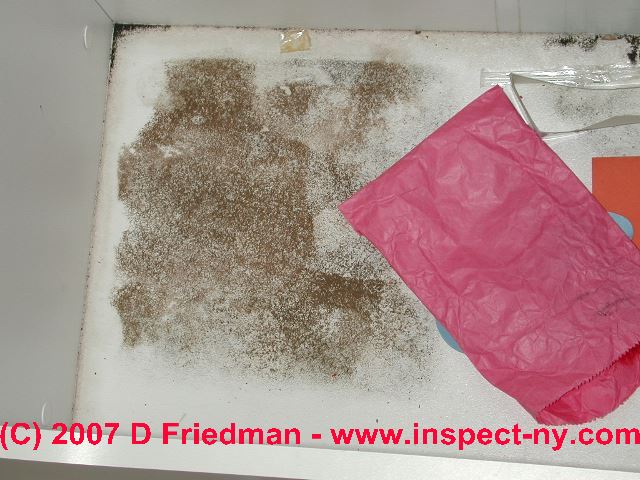
These photographs show two common patterns of mold growth on the upper surface of a carpet that was left wet in a building. In the left photograph a brown mold is growing in a rather uniform pattern without definite edges on carpet in a closet.
The black mold visible in the upper left and right portions of the photograph will probably be a different mold genera and species - this is an example of the dangers of careless sampling of mold in buildings since a lot of what people think is present in a building depends on exactly how mold samples are collected.
The right hand photo above shows two rather round black patterns of mold growth on floor carpeting in the same building.
Even if no mold was visibleOn other carpet surfaces in this building it is likely that the carpeting, if it was wet, has become mold contaminated - a condition that might be confirmed by inspection of the carpet backing, padding, or other building surfaces.
Carpets or furniture that have been wet or had mold growth: Wall-to-wall carpets and upholstered furniture that have been soaked and/or have had mold growth on their surfaces, most likely cannot be adequately cleaned and should be replaced.
Also see CARPET STAIN ID TESTS
and CARPET CONTAMINATION TEST PROCEDURE.
Carpet padding and subfloor: And where carpeting has been wet, don't forget that the padding below the carpeting and even the floor and subfloor below may be damaged or moldy.
See CARPET PADDING ASBESTOS, MOLD, ODORS.
Even carpeting which has not been wet may be a significant problem mold reservoir in a building if the carpeting has been exposed to a high level of airborne mold or other allergens. This condition occurs, for example, when a water-damaged moldy building has been remediated without proper dust and debris control.
The difference is that carpeting or upholstered furniture that has never been wet and that has not had mold growth on its surface, that is, it has been subjected to settled dust only, may often be adequately cleaned using HEPA vacuuming methods.
See CARPET DUST IDENTIFICATION
Screening samples of carpeting and other building surfaces taken outside of the remediation work area both before and after a mold remediation project can protect both the remediation company and the building owner from unanticipated additional mold cleanup work after the initial mold remediation project has been completed.
Another case of severe carpet staining [photo] due to furniture left on wet carpeting, accompanied by mold growth, is shown in this photograph.
...
How to Diagnose Stains & Discoloration on Rugs or Wall to Wall Carpeting
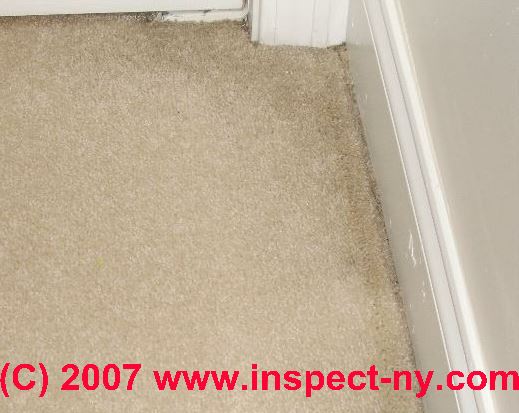
Possible thermal tracking stains are shown by the darkened debris on the floor carpet in the
left photo above, where a grayish line appears to follow the point where the wall to wall carpeting
abuts the building wall or wall baseboard trim.
See THERMAL TRACKING STAINS for detailed discussion of this phenomenon and how to diagnose it.
Possible furniture footprint stains on carpeting are suggested by the right hand photo above. Sometimes a stain like this, particularly where it follows the same shape as an object which has been placed on the carpet, suggests that the stain was deposited from the object itself, or dirt on its surface, or bleed-out if the object was placed on a carpet left damp after carpet shampooing.
A Severe carpet staining [image] due to furniture left on wet carpeting, accompanied by mold growth, is shown in this photograph.
...
How to Diagnose Light or "Clean" Areas of Carpet Surrounded by Darker Stains or Discoloration

"Clean" areas of carpet under furniture can also tell us what's been going on in a building. In the right hand photo above, the carpet appears darker inside the stain perimeter which suggests that the mark we see is either from a spill on the carpet or from the footprint of an object which was placed on the carpeting.
But if a mark on carpeting outlines an area of carpet which is lighter or cleaner than the surrounding carpeting, we usually find that an object which had been placed on the carpet was actually protecting that surface from settling dust, soot, or other debris in the building.
In this case we'd look further for an indoor source of high levels of airborne soot or other debris, such as a malfunctioning gas or oil fired heating system.
Because such heating systems could be unsafe (for example, risk of fatal carbon monoxide poisoning), the inspector should be one who is quite familiar with inspection methods and indicators of an unsafe or improperly-functioning heating or cooling system.
Usually soot marks, thermal bridging, or thermal tracking stains appear, if at all, in the building interior locations listed just below discussed in the remaining sections of this article.
...
Photos & Diagnosing Stains on Building Walls and Ceilings
Common stains on painted inteior walls and ceilings include
- Black smudges and streaks on walls and ceilings -
see THERMAL TRACKING & THERMAL BRIDGING where we describe indoor dust deposition patterns, soot stains, and other dark indoor stains often mistaken for mold (photo at left). In our thermal tracking stain article series we also distinguish candle and fireplace soot staining
Stains from Candles, Woodstoves, Fireplaces from other indoor stain sources. - Dirt and soiling including from pets or other animals -
See PET STAINS & MARKS in BUILDINGS
and PET STAINS on WALLS - HUMAN OCCUPANT STAINS ON WALLS
Human occupant stains may also be from smoking. In rooms occupied by heavy smokers we have found brown stains on walls and ceilings. If there are occasions of high indoor moisture and condensation on walls you may see concentrations of brown stains running down walls in a water pattern or droplets or small brown spots where moisture accumulated on ceilings. - Mold growth on building interior ceilings or walls
occurs on visible surfaces in buildings that have been wet or subject to high humidity, particularly on mold-friendly materials such as drywall and wood paneling. Watch out for hidden mold reservoirs in wallor ceiling cavities that have been wet - investigation may be justified.
See MOLD APPEARANCE - WHAT MOLD LOOKS LIKE for photos of mold growing on indoor building surfaces of various materials. - Also see Other Stains on Indoor Walls & Ceilings
- Red Stains on Walls or ceilings
may be due to mineral salts and efflorescence if the wall is masonry, particularly brick masonry, or the red stains may be a species of mold or even a red yeast such as Rhodotorula often found indoors in wet moldy conditions. Photo below: red stains on an interior wall, possibly wallpaper, that may be a red mold or yeast.
See RED MOLD PHOTOS
and compare those images with
EFFLORESCENCE & BROWN DEPOSITS
The contributor of this photo, C.R. (1/27/2016) commented:
... [I have ] often seen mold *behind” objects close to cold walls (due to the decreased airflow stopping condensate from evaporating, I assume) but it just seems weird to get it on a surface that should actually be *drier* than behind the pictures. Just goes to show all these different molds have their own specific preferred conditions, eh?
...
Photos & Diagnosing Stains on Building Floors other than Carpets
Common sources of stains on building floors include:
- Rust marks left on vinyl tile or sheet vinyl where floors were wet below metal objects
- Pet urine stains on wood flooring (photo at left).
- We discussed and illustrated carpet stains above.
- See PET STAINS & MARKS in BUILDINGS
and PET STAINS on WALLS for details.
...
Stains on Plumbing Fixtures, Sinks, Showers, Toilets
Stains on plumbing fixtures may be due to simply poor housekeeping or to contaminants in the water supply, or as shown on the porcelain-coated cast iron sink above, a combination of the two.
See WATER SOFTENER OUTPUT COLORS DEBRIS STAINS ODORS
and
See WATER STAINING CONTAMINANTS
...
Lines & Run-down Drip Stains on Building Surfaces
What's the cause, significance, & appropriate cleaning or prevention methods for vertical lines or run-down stains found on building ceilings, walls, cabinets, floors or other surfaces?
These reader questions and answers illustrate common causes of rivulet type run-down stains on building surfaces: it's not just paint.
What's causing these red rivulet stains running down a wall in Grandma's House?
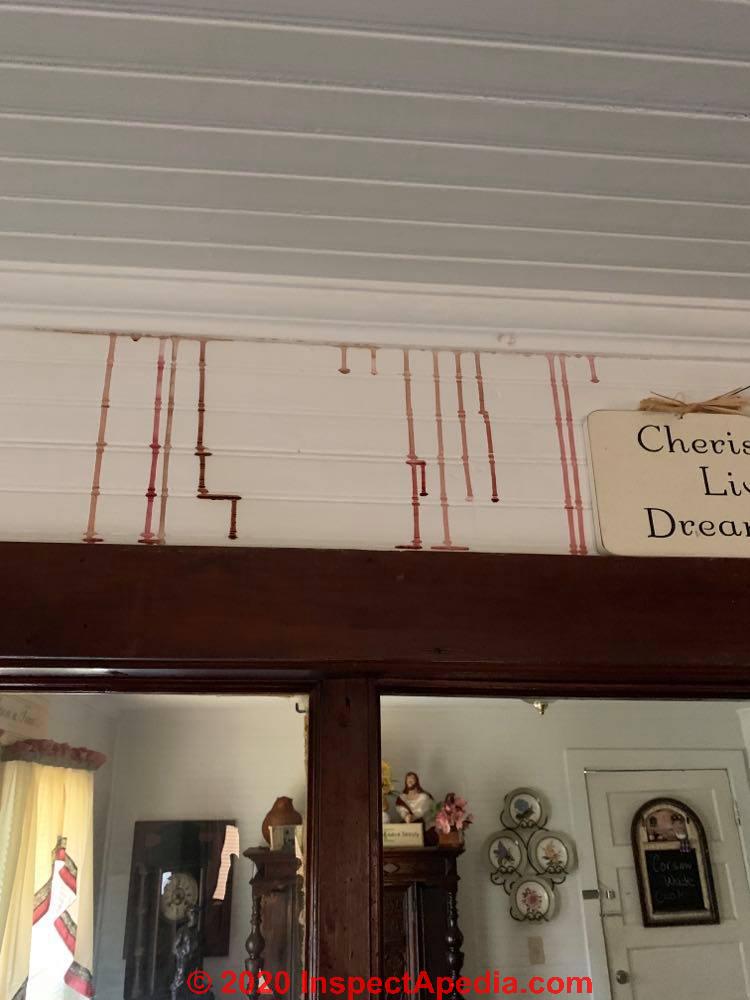 This was found on our Grandmother's house which has sat empty for a year.
This was found on our Grandmother's house which has sat empty for a year.
There is a second story above this room..no evidence on walls, floor or ceiling in second story above area.
Just in this area...it is wet and more red than brown.
No leaks in attic that we have found.
Is this mold?
Has no smell.
Thank you for any help in identifying.
cooke1and2@aol.com
Our Grandmother's house has sat empty for about a year.
We found this on the interior wall....just in this area.
There is a second floor above this wall and no evidence on floor, ceiling or walls upstairs. On 2020-09-10 by Dianne
Reply: find the exterior wall or roof leak
Dianne
There has been a leak above the point where those run-down stains appear.
The leak could be from plumbing or from a roof leak, either of which entered the building wall above this point, OR there has been a leak nearby that ran across the ceiling to find its way out at the wall-ceiling trim.
I can't get this vertical line or drip-down stain off the wall - bug related?
I am about to take a sander to the wall here. I have tried every cleaning product i can buy to get this off.
I think it might be bug-related, but I’ve only seen this one other time in my grandma’s house - also starting behind a picture.
It seems fused to the paint. Behind the picture, it just starts, then a few inches behind the dresser it just stops. Nothing on the back of the picture.
Thankfully, it’s in the spare bedroom, but I have to get it off before anyone can stay. It looks gross. Please help if you can. Thank you.
On 2021-11-21 by Michelle
Reply: termite mud tubes are fragile, easily disturbed / broken; look for a run-down stain from a coating source
@Michelle:
Often a termite mud tube looks like what we see in your photo, but that would be soft and easily broken, not something that needs to be sanded.
I'd remove the picture and pinpont the exact location of the start of that run-down or rivulet type stain on your wall.Then look at the corresponding location on the back of the framed picture to see if there is any clue such as a moisture-induced drip that dissolved something in the frame or its materials.
Follow up:
@Inspectapedia Com Moderator, wow! That was fast! I didn’t expect a reply until tomorrow. Here is a better photo. You can see it has a slightly glossy appearance. But, I’ve scrubbed and can’t get it off. It’s about a foot long. Thank you!
Reply:
@Michelle,
It does look as if something leaked out of the back of the frame or painting or whatever it is that's hung on the wall. It's worth a closer look.If a stain material leaked into the surface of the drywall it's not going to scrape off. You may need to paint the stain with a lacquer primer sealer before repainting that part of the room.
Follow up:
@Inspectapedia Com Moderator,
I looked behind the frame but there’s no corresponding stain. It’s so weird.
Bug juice - like something was smashed and the insides leaked out. I’ll take your advice though ‘cause I can’t think of anything else. Appreciate the help!
...
Spots on Building Surfaces
What's the cause, significance, & appropriate cleaning or prevention methods for small spots found on building ceilings, walls, cabinets, floors or other surfaces?
Our photo, discussed in detail below, shows light colored spots on dark cabinet doors. Our detailed examination confirmed that these spots were due to water splashes from a sink above.
Examples and suggstions are given in these readers' questions and expert replies.
Cause of Orange Spots on Bathroom Walls & Ceilings
The orange stains, pictured, accumulate on my bathroom walls and ceilings. (I have yet to notice them in tiled shower/tub stall but they're continue to reappear on the painted walls in my bathroom.)
I bought a new exhaust fan/heating unit, triple the CFM I should need for a bathroom that is under 70sq ft, and paid a hefty sum to have it installed within a year of moving into my home.
The exhaust fan, unfortunately, is anemic and does not prevent the walls from being coated with steam from use of the shower, nor does it prevent the vanity mirror from being so saturated that water runs down and pools on my vanity after a 12-15 minute use of the shower.
The question is twofold: What are these orange spots?
And was I on the right track to try to improve the exhaust ventilation in my bathroom? (The manufacturer is Delta Breeze.
I bought their largest model two years ago and can't find anything comparable in size to replace the larger hole that was cut in my ceiling to install it.)
These orange spots are difficult to reach as they end up on the entirety of the bathroom walls. Since I only notice them on the painted surfaces, would it help to repaint the bathroom without the texture — or will they reappear anyway?
I guess what I'm trying to figure out is whether I'm better off trying to revisit the ventilation issue or whether a whole house water filter is in order?
The community I live in uses a mix of local well water and State-supplied water. The piping in the house is copper. Any feedback would be much appreciated.
Thank you. On 2020-07-03 by LYNND
-
Reply: condensation causing indoor stains
Lynn
Thank you for the photo and interesting orange stain question. I can't say for certain but from zooming in on your photo and from experience these may be resulting from condensation on the bath walls and ceiling.
The stain mechanism, if this is the case as I suspect, is the following:
- condensation collects on a wall or ceiling, wetting the area
- as the condensate sits on the area it dissolves deposits on the surface such as house dust, skin cells, fibres, and in a house where there were smokers or a wood or coal stove, smoke particles (often brown or orange)
- The condensate forms drops that concentrate the stain
- The condensate droplets later dry out, leaving the stain as a spot on the surface
If you look very carefully at these stains on a ceiling or wall but especially where they appear on a wall, you might see a rivulet or droplet track where some droplets move or on a wall actually run a fraction of an inch or so down the wall in the collection, concentration, and dryout process.
Follow up:
Correction: The exhaust duct is running horizontal (accidentally said vertical).
Thank you for the reply.
No smokers or wood burning going on yet the spots reappear after they are washed away (they look exactly like the color of earwax!). Now that you point it out, I do see that it looks like it has been deposited by the fact that the condensation has formed drips.
The water is rather hard and while it runs clear at the tap it tasted like iron when we moved in, so we filter our drinking water using an Aquasana under-the-sink unit (not RO type). In talking to the water company, they deny it's anything on their end — but part of the community water is drawn from local wells. Is it possible we're seeing rust stains?
With respect to the ventilation, the Delta exhaust fan/heater unit was installed along with a duct that is running vertical to vent outside a gable. (It was installed this way because the original home build had the bathroom's venting into the attic space. Rather than cut a hole in the roof the contractor ran a duct about 9' to a gable.Is the fact that it's not venting vertically to the roof responsible for the poor performance of the exhaust fan?
Or does the sheer amount of water collecting on everything and running down the walls after a ~12 minute shower have more to do with the fact that the exhaust fan is poorly designed (if I hold up a tissue there is no suction, not even momentarily, while the exhaust fan is running).
I even tried contacting Delta for a replacement exhaust fan but the new fan works the same way — it doesn't seem to evacuate much of the moisture.)
What's the better bet — replace the exhaust fan/heater unit, replace the textured paint that seems to be allowing the water to pool in the crevices or install a whole-house water filter of some kind?
Thank you Dan!Reply:
It certainly sounds as if your vent system isn't working, and that could certainly be a major contributor to high levels of condensation. Vents can work horizontally or vertically depending on the length of run, the duct diameter, termination and other installation details.
Identify your fan brand and model and take a look at the manufacturer's installation specifications.
Sometimes condensate will even leach chemicals or materials out of the drywall or out of under layers of paint. That seems more likely to me than iron in the water but you certainly could, at very low cost, have a water sample tested for iron level.
Little Brown or Gray Spots on the Wall: Serious Concern or Cosmetic?
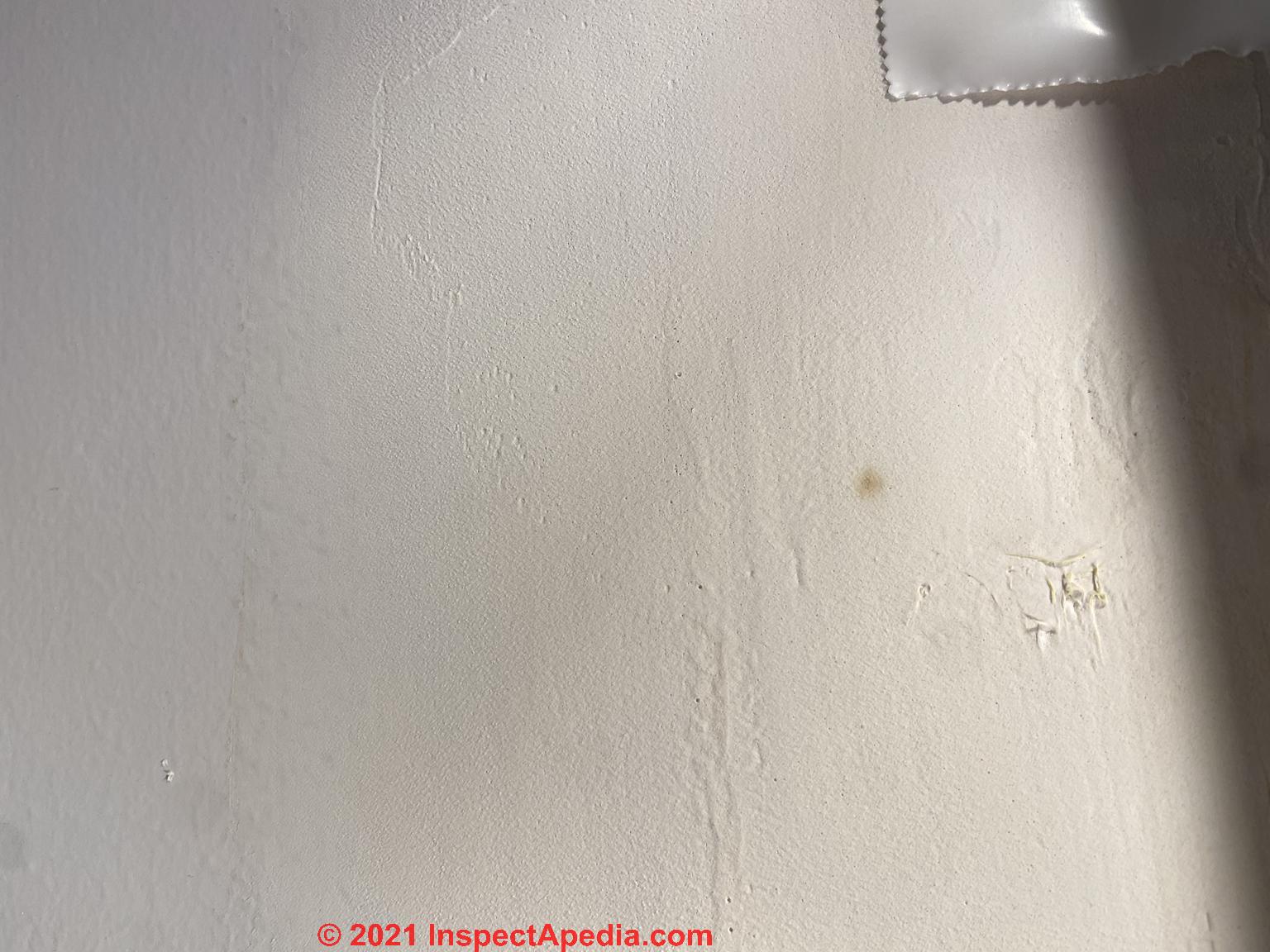
I moved into a home that was freshly painted all white.
After a month starting to notice small, 3 to 5 mm, brown spots surfacing up from under the paint in various places throughout the house.
Below: multiple spots in one wall area
Additional picture of a streak
Reply:
@Mw,
You're not going like part 2 but here goes:
Part 1: Spots on a wall: cosmetic issues alone:
If you're pretty confident that nothing has splashed onto those walls, I suspect you're seeing little spots of bleed-through of something that was on the wall before it was painted.
That can happen particularly if a property is being re-sold by a real-estate flipper who focuses on cosmetics
If that's nothing serious you can dab on a bit of lacquer primer sealer on those spots to stop bleed-through when re-painting feels (to you) justified .
If that's all we've got, then this is only a cosmetic issue.
Part 2: Spots on a Wall Hiding Bigger Trouble:
I've been (OPINION) nauseated by coming across cases of painting-over extensive and harmful indoor mold contaminated drywall on walls and ceillings. The result looks great - for a while. But "killing" mold by spraying it and / or painting over it on drywall is a serious error that leaves hidden, mold-contaminated materials in place where sooner or later you're going to be saying .... it's BACK!
The proper repair for moldy drywall is to remove all of the moldy material, remove any wet or moldy insulation behind the drywall, then find and fix the leaks, and dry out the building before completing its restoration.
IF a building was in that condition and simply painted it's likely that there are mold reservoirs not only on the painted-over drywall surfaces but on the wall cavity-side of the drywall. IF extensive in size (more than 30 sqft) then that becomes a health hazard for building occupants, more-so if occupants include people at extra risk: elderly, infant, immune impaired, allergic, asthmatic.
So what now:
- Are you an owner or renter?
- What was the building's history of leaks or water entry?
- What are the building's construction and materials? Frame and drywall?
At the very least you'll be alert for
- mold odors
- allergic reactions indoors
- signs that more and more "spots" are bleeding through the wall
and
if the level of indicators and worry justify it, then it would be appropriate to do some destructive / invasive inspecting of the most-suspect wall or ceiling cavities.
Details are at
HIDDEN MOLD in CEILING / WALL CAVITY
by Mw - mold test results negative, brown spots keep showing up
@Inspectapedia Com Moderator,
Thank you for your response. We own. House was empty for 3 months before be purchased. We had a mold test in 3 rooms & all came back negative but now these are popping up & not in areas where anything could have been splattered previously.
by Inspectapedia Com Moderator
@Mw
About your reply:
Mold tests alone as a building screen for mold contamination are simply not reliable.
Details are at MOLD TESTING METHOD VALIDITY
I am certainly not asserting that there is for sure a mold problem, I'm alerting you to that possibility. Don't go chopping out walls. yet.But consider that if poor quality or old drywall nails were used and there's indoor moisture and depending on the kind of paint used for the renovation in the home, you could be seeing bleedp-through at drywall nails.
by Mw
@Inspectapedia Com Moderator, oh I definitely think there is. I am trying to confirm it. I was shocked when the tests came back negative.
I’ve pulled back trim & ifted up carpet. Other than a few obvious areas in the bathroom, so far nothing except these spots. Which are again in just about every room so far & at random heights along the wall.
They are definitely multiplying. The worst area is that cluster which is in the kitchen above a south facing window.
I am not afraid to go cutting in the walls to get to the bottom of it. We have 2 little kids.
I guess my question would be if it is in fact mold, were there spores that landed throughout the house from hopefully one contaminated area? I understand you can’t say one way or the other, just thinking here.
I also can’t help but think its related to the fishy trim paint... thank you for your time
by Inspectapedia Com Moderator - your brown wall spots don't suggest mold. Investigate further with test cuts.
@Mw,
Mold doesn't usually grow uniformly throughout an entier building except in extreme conditions.
Diagnostic would be to review the history of building leaks and renovations.
Rather than cutting willy-nilly, I would go to the most-suspect or worst-looking areas and make a few strategic 2x4" test cuts to look into the wall or ceiling.
I describe test cuts and what to look for in the article link I gave at my earlier comment.
Green and Other Spots on Walls & Cabinet Doors
I moved into my condo first of September (still warm outside). I had the carpet and condo professionally cleaned prior to moving in.
At the end of the month, I started noticing faint, tan-like spots on both my stairwells. Now I'm starting to notice them on my furniture.
I am now starting to freak out. Can anyone help? Picture below is stairwell closest to main floor. 2021-12-05 by Greeneyes43040
This is my entertainment center
This is my closet doors
Reply:
@Greeneyes43040,
Those spots in most of your photos look as if something splashed on the surface.If the spots wipe off and re-grow they could be mold - you'd need a much closer look, or try sending a tape sample to a lab for testing, especially if they increase in size or number.
Follow up: spots are random in location
@Danjoefriedman, I thought so too but it’s random… the furniture is the opposite side of my closet doors… the stairwell is downstairs.
I think I’ll scrub all that I see and if they reappear. If they do, I’ll call someone.Reply: spots in different areas, different causes; this photo shows splash spots
@Greeneyes43040, see my markings annotating your photo:
Those look like splash-spots - something splashed on the cabinet door and was liquid enough that there was some further droplet movement, as indictated by the yellow arrows I've annotated.
...
...
Continue reading at STAIN DIAGNOSIS on BUILDING INTERIORS - home, or select a topic from the closely-related articles below, or see the complete ARTICLE INDEX.
Or see STAINS on INDOOR SURFACES, PHOTO GUIDE FAQs - diagnostic questions & answers posted originally at this page.
Or see these
Recommended Articles
- ANIMAL STAINS & MARKS in BUILDINGS
- BROWN or REDDISH BROWN RUST STAINS
- IAQ DIAGNOSIS via THERMAL TRACKING STAINS
- MOLD APPEARANCE - WHAT MOLD LOOKS LIKE
- MOLD / ENVIRONMENTAL EXPERT, HIRE ? for help in deciding when to go further
- OIL BURNER SOOT & PUFFBACKS
- STAIN DIAGNOSIS on BUILDING INTERIORS - home
- THERMAL TRACKING BRIDGING GHOSTING
Suggested citation for this web page
STAINS on INDOOR SURFACES, PHOTO GUIDE at InspectApedia.com - online encyclopedia of building & environmental inspection, testing, diagnosis, repair, & problem prevention advice.
Or see this
INDEX to RELATED ARTICLES: ARTICLE INDEX to BUILDING STAINS
Or use the SEARCH BOX found below to Ask a Question or Search InspectApedia
Ask a Question or Search InspectApedia
Questions & answers or comments about identifying the cause and finding the cure for indoor stains on ceilings, walls, floors, carpeting, furniture, and other indoor surfaces and materials
Try the search box just below, or if you prefer, post a question or comment in the Comments box below and we will respond promptly.
Search the InspectApedia website
Note: appearance of your Comment below may be delayed: if your comment contains an image, photograph, web link, or text that looks to the software as if it might be a web link, your posting will appear after it has been approved by a moderator. Apologies for the delay.
Only one image can be added per comment but you can post as many comments, and therefore images, as you like.
You will not receive a notification when a response to your question has been posted.
Please bookmark this page to make it easy for you to check back for our response.
IF above you see "Comment Form is loading comments..." then COMMENT BOX - countable.ca / bawkbox.com IS NOT WORKING.
In any case you are welcome to send an email directly to us at InspectApedia.com at editor@inspectApedia.com
We'll reply to you directly. Please help us help you by noting, in your email, the URL of the InspectApedia page where you wanted to comment.
Citations & References
In addition to any citations in the article above, a full list is available on request.
- Thanks to Pat Belkin, at Flooring Solutions for providing many of the photographs and suggesting some of the questions addressed in this web page article
- Our recommended books about building & mechanical systems design, inspection, problem diagnosis, and repair, and about indoor environment and IAQ testing, diagnosis, and cleanup are at the InspectAPedia Bookstore. Also see our Book Reviews - InspectAPedia.
- DUST FROM the WORLD TRADE CENTER COLLAPSE following the 9/11/01 attack: the lower floors of this building contained spray-on fire-proofing asbestos materials.
- In addition to citations & references found in this article, see the research citations given at the end of the related articles found at our suggested
CONTINUE READING or RECOMMENDED ARTICLES.
- Carson, Dunlop & Associates Ltd., 120 Carlton Street Suite 407, Toronto ON M5A 4K2. Tel: (416) 964-9415 1-800-268-7070 Email: info@carsondunlop.com. Alan Carson is a past president of ASHI, the American Society of Home Inspectors.
Thanks to Alan Carson and Bob Dunlop, for permission for InspectAPedia to use text excerpts from The HOME REFERENCE BOOK - the Encyclopedia of Homes and to use illustrations from The ILLUSTRATED HOME .
Carson Dunlop Associates provides extensive home inspection education and report writing material. In gratitude we provide links to tsome Carson Dunlop Associates products and services.



